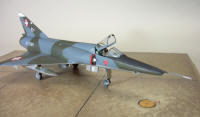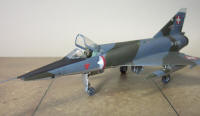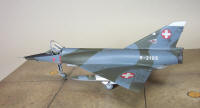|
PJ Production Kit Number 721019 1/72 Mirage III R/RD/RS/5F |
|
|
Reviewed By Clarence Wentzel, #11478 |
|
|
|
|
|
MSRP: £36.50 GBP I volunteered to review this model for two reasons. First, I love the Dassault Mirage; it was an excellent basic design that opened the door to high performance aircraft for many countries. Beyond that, I had never built a complete resin kit and wanted to see what was involved in their construction. Resin kits tend to be more expensive then injected kits but offer a wide variety of subjects not available from injection molded kits. I also had thought that they were simpler and easier to assemble. The Dassault Mirage III series restored the global reputation of France as a world class aircraft producer. The simple delta wing design offered Mach 2+ performance and could be configured to virtually any arrangement desired by the customer. The series was exported to a great number of countries around the world and achieved fame in the hands of the Israeli Defense Force/Air Force. A continual series of upgrades has enabled the Mirage to remain in front line service in many air forces to this day. The kit can produce French Air Force versions of the attack variant Mirage 5F in the markings of EC 2/13 “Alpes” and reconnaissance variants Mirage IIIR of ER 2/33 “Savoie” and Mirage IIIRD of ER 3/33 “Moselle” or a Swiss reconnaissance Mirage III RS of Fliegerstaffel 10. All of the aircraft are finished in typical European camouflage colors. The initial impression was very good. The resin parts featured very smooth surface finish and fine detail. The kit also includes a photo-etched fret covering a number of small, thin components and a bag of white metal parts for areas requiring more structural strength. The cockpit canopy is vacu-formed and two examples are included in case one is damaged during assembly. An interesting feature of the kit was that the noses of the reconnaissance versions are molded in clear material so that the camera windows will be shown neatly. Three Recon noses are included to accurately capture the subtle differences between the three versions. Two different fin/rudder assemblies are included along with a separate Doppler radar fairing. Four A4 size pages provide step-by-step assembly instructions and color and marking details. The fuselage halves are molded with cockpit side wall and nose wheel well details and the main wing includes main gear wheel well details. It looked like a quick build – two fuselage halves, a wing and a rudder/fin and most of the model was together. Then reality set in. I found a few areas were the resin parts were damaged. The fuselage pour sprues were broken off too close to the part surfaces and the tip of one rear fuselage was missing. Also, one of the mail wheel gear doors was missing, one ejection seat upper handle was missing and one of the aileron actuators was broken. During assembly, I found that the fuselage didn’t quite fit together. The nose and tail touched but there was an opening in the middle. I tried to heat the parts and force them together but I was probably too cautious. I ended up adding some filler to the fuselage spine to close up the opening as well as to fill blemishes noted above. The wing also required some filling both fore and aft and at the sides to properly join with the fuselage. The tailpipe included details of the rear of the engine and had a large pour sprue. The indicated area to cut off the sprue would have resulted in the removal the jet engine details. I ended up cutting extra material and grinding to fit. Two pieces of photo etch were added to the rear of the tail pipe to simulate the afterburner pedals. This looked good but unfortunately I found them to be too long to exactly fit around the tailpipe and then fit into the rear of the fuselage. I overlapped the parts slightly. The only other tricky area was the air intakes. These consisted of a photo etch splitter plate and resin parts for the shock cone and the intakes. These took a little bit of sanding and filling to make them look right. The only other area where the kit part was a problem was the nose probe. At first, I thought that the white metal part was some scrap metal. I was not able to straighten it out sufficiently to use and substituted a piece of stretched sprue. Ignoring all of the above minor problems, I was very pleased with the final result of this kit. It makes into an accurate representation of the Mirage III. I particularly liked the fact that the ailerons and elevators were separate parts and so I glued them on slightly drooping, like many photos. The ejection seat was also excellent – as good or better than many after-market parts. The transparent noses proved to be a good idea too. They required a little filling to make them fit the fuselage but by masking the windows before painting they look very realistic. I believe that Daco produced the decals. They were in perfect register and were very thin. No problems were encountered using them. A paint conversion chart is included which contains Humbrol, Gunze, Tamiya and FS references. I can recommend this kit to most modelers. It is well engineered and accurate. The model can be obtained directly from the manufacturer at www.pjproduction.net for 39 Euros or from Hannants for £36.50. I was not able to find a US distributor of this excellent line of resin products. A big thanks to Philippe Jacques of P J Production for the kit and to John Noack for letting me have the review. |
|
|
Information, images, and all other items placed electronically on this site are the intellectual property of IPMS/USA ®. |
|




